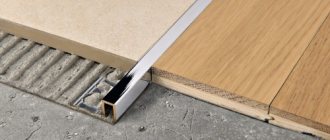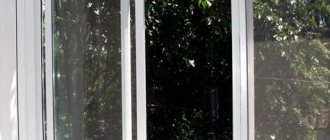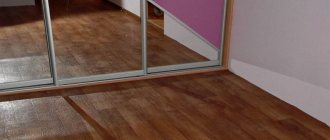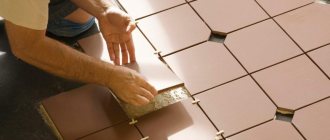What it is
Cold welding of floor coverings is a chemical method of joining materials that does not involve the high temperatures associated with conventional welding.
The adhesive composition, entering into a polymerization reaction with the linoleum material, dissolves and melts the edges of the canvases. Their plastic deformation occurs. After completing the process of interaction of the mixture with the coating, a strong seam is formed at the joints of the sheets, and the structure is uniform in structure with the material being joined.
With a high-quality connection of the canvases, the joining seam is not noticeable.
The popularity of using adhesives for joining linoleum cloths of the “cold welding” type is due to the ease of working with them, the relative low cost and the versatility of the method.
How to use it correctly?
Gluing joints between sheets of linoleum using cold welding is quite simple. To do this, you first need to stock up on some tools:
- Long ruler. It is advisable to use metal models, as they are smoother and cannot be deformed.
- Masking tape. If it is not there, then you can use a two-way analogue.
- Knife for cutting. It must be sharp, since the quality of the seam and joining of sheets depends on this.
- Substrate. Often, thick cardboard is used for this, which is placed under the seam so as not to cut along the floor. A sheet of old plywood, old linoleum or chipboard will also work.
- Means of protection. This includes gloves and a mask to protect against inhalation of caustic fumes.
To weld linoleum efficiently, you need to get an even joint between the elements. This will allow the glue to fill the gap evenly and form a strong bond. This process is quite simple and consists of several operations:
Initially, two sheets need to be placed on top of each other with an overlap of approximately 5 cm. This factor should be taken into account when purchasing material. Under them, you should first place a sheet of chipboard or old linoleum along the entire length of the joint. After this, a mark is applied to the top sheet, which will indicate the location of the joint. Please note that it is located approximately in the center of the overlap. At this stage you need to cut off the excess pieces
To do this, use a ruler, which is placed along the future seam. It is important that there are two sheets of linoleum underneath it. After this, use a sharp knife to make a cut along the ruler
You need to cut two sheets at the same time, which will allow you to form an even and minimal joint.
Bonding linoleum consists of several successive steps:
First of all, you need to read the instructions for use. Depending on the type of glue, there may be some nuances that it is advisable to take into account. Manufacturers also indicate under what temperature conditions the material can be properly glued. After this, the sheets are joined together with the sides that were previously adjusted
It is important to ensure that the material does not move when performing such operations, and that there are no air bubbles underneath it. They can subsequently “migrate” under the seam, which will subsequently collapse. To avoid glue getting on the surface of the linoleum, masking tape should be glued along the entire length of the joint.
After this, a channel is cut with a knife, which corresponds to the direction of the gap between the linoleum sheets. This must be done carefully so as not to damage the material on the side. For welding, a special attachment in the form of a small needle is put on the tube of glue. After this, they begin to feed the solution into the gap between the sheets. Initially, you need to fill the joint until a mixture with a diameter of approximately 3-4 mm appears on the surface of the adhesive tape. After this, you can sequentially move along the entire length of the seam, feeding glue inward in a similar way. When the joints are filled, you need to leave them for about 15 minutes. After this time, you can remove the tape. Complete gluing will occur in about 3 hours.
If the mixture gets on a clean linoleum surface, do not try to wipe it off immediately. Let it harden and then simply cut it off with a utility knife. Cold welding technology is a simple operation that requires only care and compliance with safety precautions.
You will learn more about how to use cold welding for linoleum in the following video.
Compound
The typical chemical composition of reactive adhesives is simplistically a mixture of solvent and filler. The concentration of these two components determines the type and technology of work.
Solvent
The following can be used as a solvent in compounds for polyvinyl chloride coating:
- Tetrahydrofuran is a compound from the ether family. It can account for up to 80% of the total volume of the mixture.
- Acetone is a common ingredient in adhesive mixtures that have fast-setting properties.
Given the good solvent properties of acetone, it can be used to make glue at home.
Finely chopped pieces of old linoleum without a base are poured with this solvent and left for at least a day until a homogeneous consistency is obtained.
Glue made from solvent and linoleum residues
But it should be borne in mind that such glue will be significantly lower in quality than factory mixtures that contain special fillers.
Adhesive
Various additives serve as additives for adhesive fillers in mixtures intended for soldering linoleum:
- plasticizers;
- polyvinyl chloride;
- polyurethane;
- PSH-LS resins.
Pigments and modifiers can also be added to the adhesive mixture. Some manufacturers, for reasons of trade secrets, do not advertise information about component substances.
Types of cold welding for linoleum
There are three main types of compositions for non-thermal joining of linoleum - A, C and T. This classification was introduced by Werner Müller, a German manufacturer of cold welding systems for PVC coatings.
The letter designations to some extent reflect the shape of the nozzles.
Cold welding systems
The existing differences, mainly in the concentration of the mixture, determine the purposes for which they can be used, the types of work, as well as the material of the coating itself and its base.
The compounds are packaged in tubes equipped with various types of tips and nozzles, which allows you to place the mixture precisely into a narrow seam.
Cold welding adhesive type A
Type A compound is characterized by the following properties:
- instant readiness for use, the possibility of repeated use with good sealing of the packaging;
- consistency is more liquid than other types, due to the predominance of solvent in the mixture;
- deep and rapid penetration into the coating structure;
- high strength of connections;
- waterproofness and durability of the seam.
Feature - the tube is equipped with a built-in steel needle, which is closed with a special cap.
Type A glue
Type A glue
The technology for working with this glue is not complicated, but to obtain a high-quality result from soldering, it is necessary to properly prepare the joints. The needle should be inserted into the seam deeply, in doses and filling it evenly.
Adhesive type C
Mixture C has a thick paste-like consistency. Liquid PVC in it predominates over the solvent. This glue is usually used to repair existing coatings.
The set includes a narrow C-nozzle, which is used depending on the width of the seam (from 0.3 to 2 mm). To join wider (up to 4 mm) gaps, no nozzle is needed.
Type C nozzle
By carefully squeezing the paste out of the tube, which is held vertically or at a slight angle to the coating, the seam is uniformly filled with welding.
Type T
In terms of the method of preparing the seam, glue T is similar to type A. The joint of the sheets is done using the method of a tightly cut seam.
Feature - the function of a needle is performed by the included nozzle in the shape of the letter T.
Type of T-nozzle
Useful properties:
- alignment of protruding edges of canvases;
- low absorbency of the base with pile.
The soldering technology is similar to the welding method A.
How and with what to glue linoleum joints at home
The advantage of modern repair methods and technologies is that professional work techniques can be easily repeated by anyone without serious financial costs. Even such a process as reliable and durable gluing of linoleum. It is enough to have the necessary funds and some tools on hand.
Briefly about linoleum
To understand all the intricacies of working with flexible flooring material, you first need to know the basic characteristics and classification of the product. This will definitely come in handy in the future.
So, linoleum (Latin linum - flax, oleum - oil) is a rolled material used for decorative and protective finishing of the floor. There are a lot of varieties, let’s name the two most common:
Natural (Forbo, DWL, Tarkett)
Marmoleum.
This is the very first type of linoleum products. It is made from a mixture of resin, linseed oil, wood flour, beeswax, fillers and pigments. All components are mixed in special mixers, and the resulting “dough” is rolled out onto a fabric base (jute, linen, poskon). Today this is the most expensive and safest type of product for health and the environment, better known as marmoleum.
PVC linoleum (Tarkett, Juteks, Grabo)
This is a product made of thermoplastic mass, coated with a special protective layer - transparency. The base can be foamed polyvinyl chloride (VPVC) or synthetic felt (polyester fiber). High-quality material is moisture-resistant, durable, non-biodegradable, easy to install and maintain.
The range of polymer and natural linoleum products is huge. According to the scope of application, there are:
- Household flooring material intended for residential premises.
PVVC base, felt or combined. The thickness can reach 5 mm; some manufacturers add reinforcing fiberglass between the decorative and base layers. Transparent transparency can be “mono” or with additives (bactericidal, antistatic, protective, etc.). On average it lasts about 10 years. The structure of household linoleum. - Semi-commercial is an analogue of the household series, but with a denser composition and a durable protective layer. Designed for installation in high-traffic living rooms, offices, service areas, corridors, etc.
- Commercial – coating with a high degree of resistance to abrasion loads. This is linoleum for industrial, commercial and public purposes. The method of installing it is not easy, but its service life is impressive - 25 years or more.
- Highly specialized - a special type of product for extreme operating conditions. Such linoleum can easily withstand all kinds of deformations, absorbs well and has anti-slip, current-dissipating, acoustic and other properties. The thickness of the coating can reach 10 mm, the service life is up to 50 years. Designed for sports and dance halls, railway, air and sea transport, hospitals, laboratories, etc.
By structure they produce:
- Homogeneous - a homogeneous layer, the pattern in which is repeated throughout its entire depth. This series includes commercial and specialized coatings.
- Heterogeneous - a multilayer material consisting of a protective layer, a decorative base layer and a base.
According to the class of wear resistance to abrasive loads, it is divided into coatings of 21-23 (household), 31-34 (semi-commercial and commercial) and 41-43 classes (commercial and specialized).
The number of decors can be envied by any other finishing material. They produce smooth and structured linoleum like boards and palace parquet, matte porcelain tiles and glossy marble, textiles and even with images of paintings, graphic drawings, etc.
Linoleum, according to manufacturers' recommendations, should be laid using polymer glue. That is, an adhesive compound is applied to a flat, strong, dry base, the floor material is spread and smoothed.
And if 2 or more pieces are mounted, then a problem arises - how to fix the seam? We will describe the features of this technology below.
How to glue linoleum at joints
To prevent the seam from coming apart in the future, you can secure it using an aluminum or plastic threshold. But this method is not suitable for many. Therefore, a chemical method comes to the rescue here - cold or hot welding. Let's take a closer look.
Cold welding
This is an adhesive polymer mixture that consists of almost the same components as PVC linoleum. Tetrahydrofuran or synthetic rubber compounds are used as a base. The mechanism of action is simple: upon contact with the flooring material, the adhesive composition reacts with it and slightly melts the edge. The result is that the edges are joined, the seam is almost invisible, waterproof and durable.
The material works on natural and PVC linoleum of all types - from household to commercial. Most often the product is used for work in residential areas.
Of particular importance is the composition of the material - homogeneous or multilayer. The type of adhesive mixture used depends on this. Such giants as Forbo, Tarkett, Werner Müller produce the following types of cold welding:
- Type A – transparent adhesive for gluing seams of PVC coverings, homogeneous or heterogeneous, on a foam base.
The joint must be tightly cut, that is, obtained as a result of trimming the edges of overlapping sheets. It is applied with a special needle built into the tube cap; Cold welding type A. - Type T – paste for gluing joints of linoleum on a polyester and combined (PVVC + PE) basis.
Synthetic felt does not have high density and uniformity, so a “stronger” and thicker compound is needed. To introduce glue into the seam, use a needle or a nozzle with a T-shaped nozzle. Cold welding type T. - Type C is a thick repair composition that allows you not only to glue seams with a gap of 0.3 to 4 mm, but also to fill the space with a transparent waterproof mixture.
Inserted into the joint using a C-shaped nozzle. You can also use this glue for various PVC profiles, gluing wallpaper, strengthening carpet loops, repairing leatherette upholstery and much more. Cold welding type C.
Products processed by cold welding can be used in the temperature range from -40 ºС to +60 ºС. Any variety is slightly toxic and flammable, so you need to protect it from fire, heat, and use personal protective equipment (gloves, goggles, respirator) when working.
Hot welding
This term denotes a process, the essence of which is the following: a welding cord of a color suitable for PVC or natural marmoleum is tucked into a special nozzle for a hair dryer, melted in it and applied to the area where the linoleum is being glued. The excess is cut off, and the seam is strong, resistant to deformation and stress.
Welding cords are made from complex polymer compounds with the addition of pigments. Since the product is produced in a wide range of decors, the manufacturer’s range of styling accessories includes at least 100 shades. If you wish, you can order your own shade, but the execution time is not short - up to 3 months.
Bonding technology using a welding cord is recommended for all linoleum products in rolls and tiles. Because specific tools and equipment are required, this method is most often used by teams of professional installers on commercial homogeneous and heterogeneous pavements that are laid over large areas.
Application of cold welding
You will need:
- Adhesive for gluing “cold welding” seams of the type suitable for your material. For natural and polyvinyl chloride homogeneous and heterogeneous coatings this is category A or C (for wide gaps), for felt-based products - series T.
- A construction knife, a roller cutter or a special edge trimmer.
- Metal ruler or guide.
- Paper (painting) adhesive tape, double-sided tape (for gluing the sliding cut to the base).
- Soft cloth to remove dust.
- Construction hair dryer for heating hard linoleum (semi-commercial or commercial)
- Rubber roller for rolling seams or cork block.
Tools for working with cold welding.
The surface under the linoleum should be clean, free of dust and foreign debris. The coating should also be thoroughly wiped, removing dust and greasy marks. According to the manufacturers' recommendations, the flooring material is first glued over the entire area; after a day, the edges of the canvas can be processed.
First of all, you need to get a so-called tightly cut seam, that is, an absolutely even and well-fitting joint. To do this, the edges of the linoleum pieces are overlapped (from 3 to 5 cm). The strips are pressed with a steel ruler or strip and both sheets are cut simultaneously with a sharp knife or a special cutter. The trimmings are removed.
If necessary, one of the linoleum sections is fixed to the base using double-sided tape. If you are afraid of damaging the top protective layer, then you can glue paper adhesive tape to the edges before trimming, and after work, remove the remains along with the trimmings.
Scheme of working with cold welding glue.
Now you can glue masking tape onto the resulting tightly cut seam. It will protect the linoleum from excess glue, but it is necessary to seal the joint by rolling the tape with a rubber roller. You need to carefully make a cut in the middle with a knife and heat the coating a little with a hairdryer. Next, put a needle attachment on the tube, insert it into the cut and carefully squeeze out the glue, gradually moving along the seam. After 10-30 minutes (according to the instructions on the package), you can remove the paper tape
When working with type C cold welding, the joint area must be cleared of debris, glue residues, etc. Place a nozzle with a flattened nozzle on the tube and slowly fill the seam with transparent glue with a small margin (adhesive compounds shrink up to 75%). Allow to dry for 2-24 hours depending on the width of the gap. If necessary, repeat the process by applying glue over the old one.
It is not advisable to fill gaps of 4 mm or wider with two parallel or more seams. It is better to glue a strip of linoleum.
Hot welding work
To glue the joint of commercial linoleum sections, you will need:
- Welding cord of a suitable shade.
- Construction hair dryer with a special nozzle.
Hot air gun for working with welding cords. - Milling machine or hand cutters for cutting grooves 3.2-3.5 mm wide, 0.8-0.9 mm deep (for heterogeneous linoleum) or 2/3 of the coating thickness (for homogeneous commercial varieties).
- Special month-shaped knife with a guide for removing excess.
Advice! The temperature and speed of welding work must be adjusted based on the characteristics of the coating. For optimal results, it is advisable to carry out a test weld on scrap or a small section.
Work order:
Groove Formation
Correct groove shape and seam.
For all types of linoleum, a semicircular cutter is suitable, with which a gap is cut, which will subsequently be filled with the melted cord. If a homogeneous commercial pavement is being laid, it is better to use a triangular hand tool or a router. In the latter case, it is necessary to leave a small gap of 0.3 mm wide between the canvases.
Irregular groove shape and seam.
Carrying out welding
Measure the length of the future seam and cut the appropriate amount from the roll. Insert the tape into the nozzle and turn on the hair dryer. The device must be held straight so that hot air falls on the cord and partially into the cut channel. Press the edge of the heated strip to the joint and, gradually moving, completely fill the groove with it.
Removing excess
Removing the protruding part of the welding cord.
After the cord has cooled a little, trim the protruding part with a knife with a guide. Final adjustment and smoothing should be carried out after the work area has cooled completely.
The finished coating should be monolithic, waterproof and almost invisible. To get the perfect result, entrust styling to professionals.
masterskayapola.ru
Criterias of choice
The efficiency of welding linoleum coating depends on the selection of the adhesive composition. All types of mixtures for non-thermal gluing of PVC have a transparent structure and do not disturb the color scheme in the seam area.
But it is necessary to take into account a number of conditions that determine the use of different types of adhesives.
The choice depends on the type of linoleum
Adhesive mixtures A and C are used with PVC coatings.
Class T cold soldering compound is used when connecting:
- polyester materials;
- heavy multi-layer commercial fabrics;
- linoleum on a duplicated basis.
This is a material based on felt (textile) and fiberglass.
Duplicated linoleum
Attention! Type A mixture is not suitable for soldering linoleum on a felt base.
Cover age
When working on cold soldering, it is necessary to take into account the properties of the coating:
- Compound A is used to join new linoleum;
- more viscous composition C - for repairing old coatings;
- T-class can be used to work with material of any age, but new installation is preferable.
Quality and shape of linoleum cutting
To achieve a good result in terms of strength and appearance of the seam when joining fabrics with compositions A and T, it is necessary that the joint be prepared with high quality, without cracks.
Preparation of the joint of the panels
The use of type C welding does not imply strict requirements for the quality of preparation of the panels for gluing. The predominance of polyvinyl chloride in this mixture allows:
- fill wide, up to 4 mm, seams;
- solder uneven edges of the canvas;
- join fabrics with complex cutting shapes, make appliqués.
Experience of the person who will perform the work
The simplest technology is considered to be joining linoleum sheets or repairing them using a more viscous composition of grade C.
With some skills, working with mixture “A” is not very difficult. An inexperienced repairman can also handle them.
But technical difficulties may arise with T-welding of multilayer semi-commercial and commercial coatings of a higher class. Therefore, repair specialists often work with this compound.
How to glue linoleum using cold welding
Today linoleum is available in a variety of sizes. There are even rolls five meters high. However, sometimes it still becomes necessary to glue pieces of material together. The reasons may be different, as well as connection options.
There are several ways to join pieces of linoleum. The very first method, which was in use during Soviet times, has undergone changes and no longer creates such ugly seams as before. It is called hot welding of linoleum. This procedure is performed using a welding cord at a temperature of about 350-400 degrees. However, hot welding is suitable for hard and rough types of material. It cannot be used at home.
Cold welding of linoleum
Cold welding of linoleum is intended for soft varieties of material and is ideal for the home. This procedure has little in common with welding. It's more of a gluing thing. The work uses PVC glue, which causes a chemical process in linoleum that firmly and softly connects the parts of the material. While hot welding would cause warping of the surface, cold welding leaves no visible marks. Before gluing linoleum using cold welding in your apartment, you need to select the required type of procedure. And there are only three of them.
Types of Cold Welding
Cold welding A
Cold welding type A is suitable for completely new linoleum. It can also be used on hard commercial flooring. Liquid PVC glue ideally glues even pieces together, creating a single surface. It is impossible to distinguish the place of gluing if the linoleum pattern is correctly adjusted. You can only find the seam by touch.
Type C
Cold welding type C
Type C welding is used when there are noticeable, fairly large gaps between the pieces of linoleum. These can be seams up to 4 mm in size. Here, PVC glue has a thicker consistency and is even capable of creating a new layer of linoleum in place of a very wide seam. When the seam dries, the excess glue can be removed. This method is relevant for old linoleum. With type C welding, the material can be given a second life.
Type T
Cold welding type T
This type of welding is used for linoleum on polyester. It is not very common among amateurs, but is used by masters.
How to do cold welding at home
Any beginner, even a child, can carry out the cold welding procedure. It is worth considering, however, that an absolutely invisible seam is only possible on homogeneous linoleum, without insulation.
- First you need to prepare tools and materials. You will need PVC glue of the required quality, a ruler, tape, a piece of plywood, double-sided adhesive tape and a knife for cutting linoleum.
- Linoleum is cut evenly using a knife. It is better to place plywood under the pieces of material so that the knife does not become dull. Now you need to glue the linoleum to the floor so that the parts fit together smoothly. To do this you will need double-sided adhesive tape.
- Before cold welding, the front surface of the material must be protected. To do this, you need to stick tape on both parts so that only the cuts remain where the glue will be applied.
- After protecting the edges, welding can be done. Glue can be applied to two pieces at the same time or one at a time to each. The easiest way is to simply pass the tube along the cut of two already prepared parts of the material (as in the described case). If you apply the composition to each of them, then you need to glue them to the floor one by one.
- After the PVC enters the cut, a polymerization process occurs. After some time, removing the tape, you will be able to see the result. If all requirements are met, the seam will be almost invisible.
- Excess glue on the seam can be cut off. However, there is no need to rush with this; it is necessary that the composition dries well.
stroysvoimirukami.ru
Consumption: influencing factors and figures
Information about how many linear meters of joint a tube will be enough for is indicated by the manufacturer in the user instructions or on the packaging.
Consumption data on packaging
The amount of glue consumed for cold welding of linoleum is linked to a number of factors:
- Characteristics of the welding itself, declared by a specific manufacturer.
- Thickness of the material being joined.
- Master's qualifications (not always last).
After analyzing this information for mixtures of different brands, you can derive the average consumption rate by type of glue:
- A - 2.2 g per 1 linear. m;
- C - 3 g per 1 linear. m;
- T - 6.3 g per 1 linear. m.
It should be borne in mind that composition “C” shrinks up to 30% of the volume initially embedded in the seam. This feature makes it necessary to refill the joint with glue, sometimes several times, which increases its consumption.
Connection methods
The following methods are most often used to join the edges of linoleum:
- Fastening with double-sided tape. The method is simple, cheap and easy to implement. A strip of double-sided tape is glued to the back of the edges of the linoleum. Gradually removing the protective strip from the opposite side of the tape, glue both strips to the base of the floor. Unfortunately, the connection is unreliable and the joints of the individual sheets are visible.
Connecting linoleum with double-sided tape
- Pressing the seam with a threshold. This method is convenient to use at the junction of rooms. It is simple to implement and provides a reliable connection. Thresholds are available from different materials. They can have different sizes. Unfortunately, the color range of such thresholds is small. In addition, such a threshold is slightly higher than the floor level, which can create certain inconveniences.
Using a threshold you can reliably close the joints of linoleum - Hot welding of linoleum . Joining linoleum by hot welding requires a special tool. This method can be used for welding industrial linoleum, but is not suitable for household use. During hot welding, a temperature of 4000°C is reached, and household linoleum simply begins to melt and deform.
- Cold welding of linoleum . When using this technique, linoleum joints are glued together using a special glue. This is the ideal balance of simplicity, low price and connection reliability.
As you can see, each of these methods has its own advantages and disadvantages. The simplest and at the same time reliable method is cold welding of the edges of linoleum.
Manufacturers and brands
The main manufacturers of cold welding adhesives can be judged by the rating of this product and the number of offers on the construction market.
Werner Muller
This is a world-famous German company founded by Werner Müller in Bindersheim.
Compounds for Werner Muller linoleum types A, C and T are represented by the Tarkett Rumix brand.
Brand Werner Muller Tarkett
Packaging - metal tube 50 ml.
Mixes for PVC material under this brand are distinguished by an excellent quality standard. When properly stored, they remain suitable for 3 years.
A short overview video about cold welding types from Werner Muller can be viewed below.
Cold welding Tarkett Werner Muller
Homakoll
Khomakol is a leading Russian company focused on the production of construction and industrial chemical products. Adhesive materials for household and professional use are one of its core areas.
The cold soldering adhesive from this company is represented by the S 401 brand.
Homakoll S 401
The mixture is suitable for joining all types of household and commercial PVC coatings and, according to consumer reviews, has many advantages:
- reliability of connections;
- preventing edges from beading;
- good waterproofing qualities of the seam;
- durability.
Packaging - 60 ml.
Master Teks
Adhesives and sealants produced by Mastertex (Poland, Russia) enjoy a large number of offers and good demand on the market.
Adhesive for cold soldering of linoleum and plastic is produced under the Master Teks Profmaster brand.
The basis of the adhesive composition is PVC resin.
Useful characteristics:
- the ability to glue complex figured seams and perform appliqué;
- high degree of adhesion;
- elasticity and transparency of the seam;
- moisture and heat resistance.
Master Teks glue
Package volume: 115 ml.
Liquid welding for linoleum
In order to weld linoleum, there are two types of glue: A and C (Latin).
Glue marked “A”: this type of glue does not have the consistency typical of most adhesives; it has a high degree of fluidity.
At the same time, he quickly melts the surfaces of the linoleum edges and binds them together.
This glue is perfect for removing seams and scratches on the surface of linoleum.
Glue marked “C”: This glue has a thicker appearance, this is explained by the fact that it is used for joining linoleum that was laid some time ago.
Helpful Tips for Cold Welding
To obtain a durable, high-quality and invisible seam using the non-thermal soldering method, there are several useful tips:
- carefully read the instructions for the adhesive and determine its suitability for working with a specific type of floor covering;
- with liquid compounds, the canvases are joined along an edge cut with the double-cut method - a double cut of overlapping canvases;
- the junction (edges of the canvases) and the base must be cleaned of debris and dust, degreased;
- to protect the edges of the canvas from melting, the seam is sealed with masking tape, followed by a cut in the center;
- the frequency of repeated filling of joints when the glue shrinks should be at least 2-3 hours;
- Before soldering, it is advisable to heat the seam area of hard coatings of semi-commercial and commercial classes with a hairdryer to a temperature of 40°C, but no more;
- To remove glue that accidentally gets on linoleum, you cannot use solvents - only soapy water, and as quickly as possible;
- When filling a seam with glue, you need to use two hands - guide the needle with the finger of one, and hold the tube with the other.
Technology for soldering linoleum
A prerequisite for using reactive adhesives is compliance with safety measures.
Work must be performed in a well-ventilated area, hands must be protected with gloves, eyes with goggles.
To summarize, we can say that cold soldering using high-quality modern compounds is a worthy alternative to other methods of joining linoleum, both in terms of quality and ease of execution.
Cold welding technology
The glue sets in 48 hours
Welding linoleum with your own hands using the cold method is not a complicated process, and anyone can do it with minimal construction skills. The process can be roughly divided into 4 stages:
- Creating a butt seam. At this stage, it is necessary to lay the linoleum in such a way as to minimize the width of the gap between the rolls. To do this, place the edges of the layers on top of each other, mark the cut location, taking into account the matching pattern, and cut the linoleum with a special construction knife. The cut parts must be secured with tape on the back side.
- Cleaning the connection area. Before gluing linoleum using cold welding, it is necessary to thoroughly clean the edges of the cut from dust and any contaminants. After this, it is worth protecting the outer side of the coating with masking tape to avoid the ingress of solvent and, as a result, damage to the appearance.
- Application of solvent. Slowly apply glue to the inside of the joint, being careful not to touch the outside surface. Prepare a clean cloth in advance to wipe away any spills that fall on the surface if necessary. You can apply glue by running the tube along the seam. It is permissible for the glue to protrude 4 mm from the surface.
- The period of setting and hardening of the glue is 48 hours. During this time, the glue can create sagging. Once dry, remove the masking tape and cut off any tabs. Be sure to wait until the glue has completely hardened so that when removing excess you do not damage the solidity of the joint.
For linoleum, cold welding can be done in different ways:
- pouring glue into the seam between the canvases fixed to the base;
- Having glued one sheet to the base of the floor, fix the second one to it with glue. See this video for all the details of the process:
When replacing or repairing damaged flooring, apartment owners have a question: how to solder linoleum? The cold welding method guarantees a monolithic, even connection, which is not inferior in strength to thermal welding, but does not require complex professional tools.











